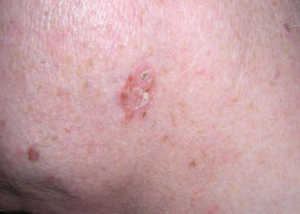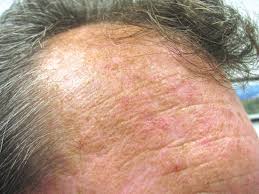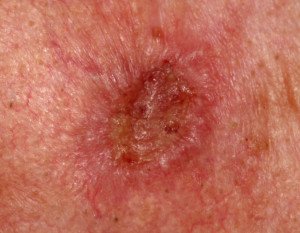
What is squamous cell carcinoma? It’s the second deadliest skin cancer.
Squamous cell carcinoma, which is directly tied to sun exposure, kills about 3,500 Americans yearly.
But squamous cell carcinoma doesn’t have to be deadly, as it is usually slow-growing skin cancer.
About 250,000 Americans are diagnosed with squamous cell carcinoma every year, and though it’s tied to sun exposure, a squamous cell carcinoma can develop in the anus and inside the mouth.
About 5 percent of squamous cell carcinoma metastasizes (spreads) to other sites in the body, and this is because, quite frankly, the patient never gets the developing skin cancer lesion checked by a doctor.
This skin cancer can also cause local destruction as it invades surrounding tissue.
Some squamous cell carcinomas can pass as a “normal part of aging,” as they can sometimes appear as mere reddish or pinkish scaly discolorations on the face or hands, or on the tops of balding heads.
Squamous cell carcinomas arise usually in sun-exposed areas, including behind the ear.
A squamous cell carcinoma on the face or hands can go completely ignored, especially if it “blends in” with other skin changes due to aging and benign changes due to sun exposure such as pigmenting and actinic keratosis.
Some people see the lesion but it never dawns on them it can be skin cancer.
With 46 million Americans without medical coverage, it’s not difficult to understand how an aging person can just let a growing nodule or scabby, crusting area on his skin go unchecked.
However, more and more people under age 40 are being diagnosed with squamous cell carcinoma.
Beware of pink or reddish, patchy or scaly areas developing on the skin, as well as reddish or pink bumps or nodules, some of which may have a protruding, horn-like feature.
Many benign skin conditions can be described as knobby, bumpy, crusty reddish patches, but any changes in your skin warrant a visit to a dermatologist.
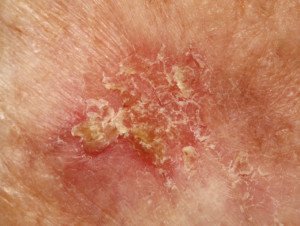
Squamous cell carcinoma. Shutterstock/Dermatology11
I asked questions about squamous cell carcinoma to Jason R. Lupton, MD, board certified dermatologist practicing in the San Diego, CA area.
Actinic keratosis, which is very common, results from sun damage, and if left untreated, 5-10 percent of these morph into squamous cell carcinoma.
I asked Dr. Lupton how a doctor can tell the difference between actinic keratosis (which many people have but don’t realize it) and early squamous cell carcinoma.
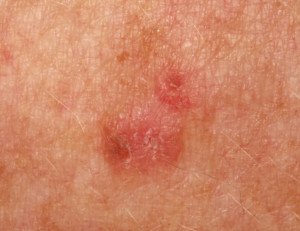
Actinic keratosis. Shutterstock/Dermatology11
Dr. Lupton: Sometimes it is hard to distinguish between AK and early SCC. This is sometimes determined by response to treatment — if a lesion responds to basic treatment — liquid nitrogen or topical therapies — then a further pursuit is unnecessary.
If it does not, then the lesion is biopsied to determine if it has changed over into an SCC.
Typically SCC’s feel more pronounced, a little bumpier, rougher and bleed more easily and are just more “hearty” lesions — although again, this is not exact.
Can squamous cell carcinoma develop from a common mole?
I have never heard of an SCC developing from a mole. It derives from the squamous epithelium. They are different entities.
Since squamous cell carcinoma is tied to sun exposure, how is it that it can develop inside the mouth or anus?
Squamous cell carcinoma is related to sunlight exposure, but in those other areas it is associated with preceding HPV infections. So sunlight is not everything with this type.
 Dr. Lupton specializes in skin cancer prevention and treatment plus minimally invasive cosmetic procedures including mole removal, skin rejuvenation, wrinkle reduction and acne treatment.
Dr. Lupton specializes in skin cancer prevention and treatment plus minimally invasive cosmetic procedures including mole removal, skin rejuvenation, wrinkle reduction and acne treatment.
 Lorra Garrick has been covering medical, fitness and cybersecurity topics for many years, having written thousands of articles for print magazines and websites, including as a ghostwriter. She’s also a former ACE-certified personal trainer.
Lorra Garrick has been covering medical, fitness and cybersecurity topics for many years, having written thousands of articles for print magazines and websites, including as a ghostwriter. She’s also a former ACE-certified personal trainer.
.


